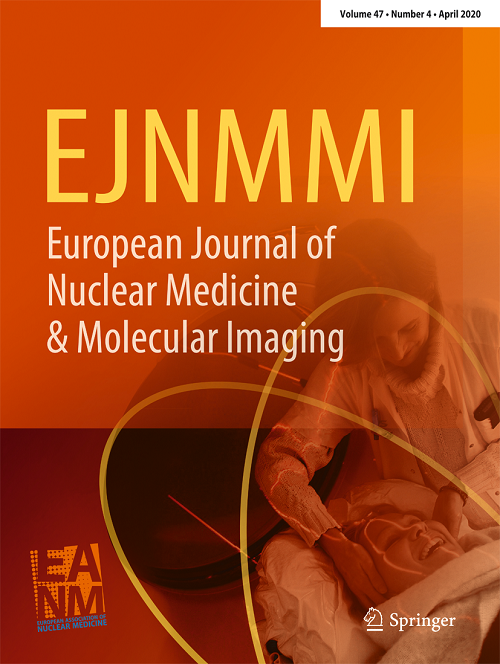The additive value of 68Ga-RM26 PET/CT to 68Ga-PSMA-617 PET/CT in assessing Post-treatment outcomes of ARSIs in mCRPC patients.
IF 7.6
1区 医学
Q1 RADIOLOGY, NUCLEAR MEDICINE & MEDICAL IMAGING
European Journal of Nuclear Medicine and Molecular Imaging
Pub Date : 2025-06-16
DOI:10.1007/s00259-025-07407-8
引用次数: 0
Abstract
BACKGROUND Besides its potential as a PET/CT tracer, the Gastrin-Releasing Peptide Receptor (GRPR) has been shown to predict the prognosis of Prostate Cancer (PCa). Herein, we aimed to evaluate the additive ability of 68Ga-RM26 PET/CT as a tracer to predict the prognosis of patients with metastatic Castration-Resistant Prostate Cancer (mCRPC) following Androgen Receptor Signal Inhibitors (ARSIs) therapy. METHODS This retrospective single-center study involved patients who underwent both 68Ga-PSMA-617 PET/CT and 68Ga-RM26 PET/CT scans. Based on the GRPR status of their lesions (positive/negative), the patients were stratified into two cohorts, and their actual prognosis was assessed by comparing their maximum Prostate-Specific Antigen (PSA) response rates and Progression-Free Survival (PFS) durations following ARSI therapy. RESULTS This study involved 44 patients. Among them, 41 and 23 showed PSMA uptake and GRPR uptake, respectively, with 3 exhibiting GRPR uptake alone. The GRPR + group had an median PSA response rate of 37.78% and a median PFS duration of 8.9 months, both of which were significantly lower than those of GRPR- patients, whose corresponding values were 69.39% and 14.37 months, respectively. According to the multivariate analysis results, GRPR status, distant Lymph Node Metastasis (LNM) and PSMA SUVmax of bone metastases lesions were significant predictors of the PSA response rate. Furthermore, the GRPR status and PSMA SUVmax of regional lymph node metastases were significant predictors of PFS. CONCLUSION Compared to GRPR- patients, mCRPC patients with GRPR + lesions exhibited a lower median maximum PSA response rate and a shorter median PFS duration following ARSI treatment, implying a poorer response to therapy and relatively worse prognosis in the latter subgroup.68Ga-RM26 PET/CT与68Ga-PSMA-617 PET/CT在评估mCRPC患者arsi治疗后结局中的相加值
除了作为PET/CT示踪剂的潜力外,胃泌素释放肽受体(GRPR)已被证明可以预测前列腺癌(PCa)的预后。在此,我们旨在评估68Ga-RM26 PET/CT作为一种示踪剂的加性能力,以预测转移性去势抵抗性前列腺癌(mCRPC)患者在雄激素受体信号抑制剂(ARSIs)治疗后的预后。方法本研究为回顾性单中心研究,患者均接受了68Ga-PSMA-617 PET/CT和68Ga-RM26 PET/CT扫描。根据患者病变的GRPR状态(阳性/阴性),将患者分为两组,通过比较ARSI治疗后患者的最大前列腺特异性抗原(PSA)应答率和无进展生存期(PFS)持续时间来评估患者的实际预后。结果本研究纳入44例患者。其中41只和23只分别摄取PSMA和GRPR, 3只摄取GRPR。GRPR +组PSA应答率中位数为37.78%,PFS中位数为8.9个月,均显著低于GRPR-组69.39%和14.37个月。多因素分析结果显示,骨转移灶GRPR状态、远处淋巴结转移(LNM)和PSMA SUVmax是PSA应答率的显著预测因子。此外,区域淋巴结转移的GRPR状态和PSMA SUVmax是PFS的重要预测因子。结论与GRPR +病变的mCRPC患者相比,ARSI治疗后,GRPR +病变的中位最大PSA反应率较低,中位PFS持续时间较短,表明后者对治疗的反应较差,预后相对较差。
本文章由计算机程序翻译,如有差异,请以英文原文为准。
求助全文
约1分钟内获得全文
求助全文
来源期刊
CiteScore
15.60
自引率
9.90%
发文量
392
审稿时长
3 months
期刊介绍:
The European Journal of Nuclear Medicine and Molecular Imaging serves as a platform for the exchange of clinical and scientific information within nuclear medicine and related professions. It welcomes international submissions from professionals involved in the functional, metabolic, and molecular investigation of diseases. The journal's coverage spans physics, dosimetry, radiation biology, radiochemistry, and pharmacy, providing high-quality peer review by experts in the field. Known for highly cited and downloaded articles, it ensures global visibility for research work and is part of the EJNMMI journal family.

 求助内容:
求助内容: 应助结果提醒方式:
应助结果提醒方式:


